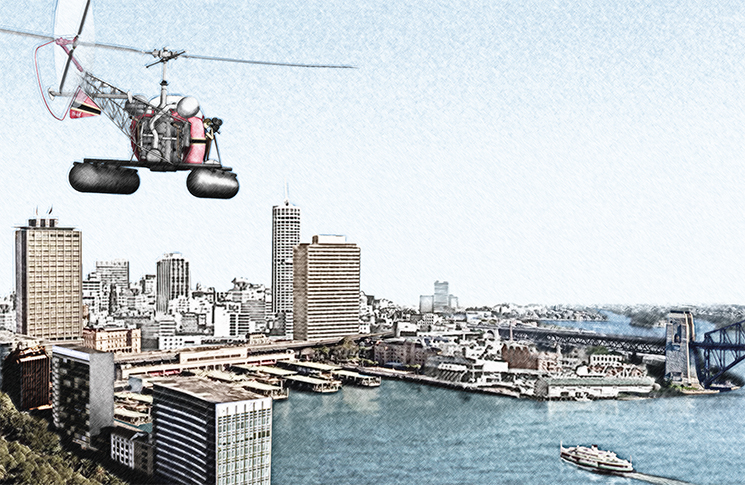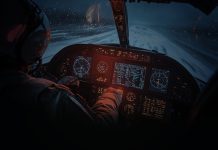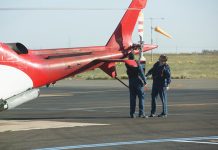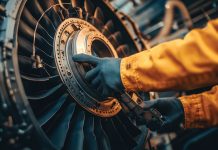Bell 47 G2, VH-AHF
Pitt Street, Sydney NSW,
Saturday 10 December 1966
The crash of a helicopter onto a city street shocked a nation.
‘In aviation, there is no problem so great or so complex that it cannot be blamed on the pilot.’ – Earl Wiener
For about a minute, it would have been a vibrant picture of modern Australia, with the summer sun reflecting the blue of Sydney Harbour, glinting off the daring skyscrapers and shimmering through the perspex dome of a Bell 47, one of fewer than 50 helicopters in the country.
This individual Bell 47 was emblematic of a young confident nation – it had starred in the first episode of a new television drama about Skippy, a ‘bush kangaroo’, that was being sold all over the world.
Onboard the helicopter were Jim Reilly, 44, a former Lancaster bomber pilot, camera operator Frank Parnell, 41, and television director Patricia Ludford, 28. Their unstressful mission on this seemingly perfect day was to take footage of yachts on Sydney Harbour.
Peter Hobbins, a historian of technology at the Australian National Maritime Museum, describes what happened next. ‘Just as the Bell 47 approached the ferry terminal at Circular Quay, a retaining bolt in the tail rotor failed and the tail rotor blade and then the tail rotor gearbox detached from the helicopter and fell into the harbour beside ferries,’ he said.
‘The helicopter then started to rotate under the torque of the main rotor and, for the next 45 seconds, was spinning effectively out of control over the Sydney central business district until it hit the back of Goldfields House, where the tail boom detached and the cabin fell inverted onto a building in Pitt Street, killing all 3 on board.’
The horrible sight was seen by thousands of people and, unusually for the time, was caught as a moving image – twice. A film crew on a tug in Sydney Harbour detached their heavy camera from its mounts and filmed the helicopter pitching and rotating in its descent. This was shown on the Saturday evening television news. The following morning a sharp-thinking reporter rescued film from the cine camera that had been on the helicopter from a rubbish bin. Although the final 17 seconds were, perhaps mercifully, unsalvageable, the developed film vividly evoked the helicopter’s whirling downfall. ABC TV news broke into its Sunday afternoon programming with the footage.
Anatomy of a fall
About the time of the special news bulletin, the wreckage of the helicopter was being lifted from the Paul Building in Pitt Street and driven to Bankstown Airport. There it was joined by items found in the water near Circular Quay. Department of Civil Aviation (DCA) inspectors made a prompt preliminary finding.
The next day the DCA issued an order that tail rotor hub retention bolts in all Bell 47 helicopters had to be replaced after 300 hours of flight and removed bolts were to be sent to the DCA for examination. The bolt had been rated for a life of 2,500 hours but the one on VH-AHF, the accident helicopter, had failed after 650 hours. This had caused the tail rotor blade to be thrown free of the tail rotor which, becoming out of balance with only one remaining blade, had gone on to detach the tail rotor gearbox from the airframe.
With no tail rotor to counteract the torque of the main rotor, the helicopter had begun to rotate. It also pitched violently in its descent, possibly because, without the weight of the gearbox on the tail boom, the helicopter’s centre of gravity had moved forward beyond its operational limit. This change had been added to by the placement of a cine camera and battery weighing about 40 kg on the forward right side of the aircraft on a modified tripod.
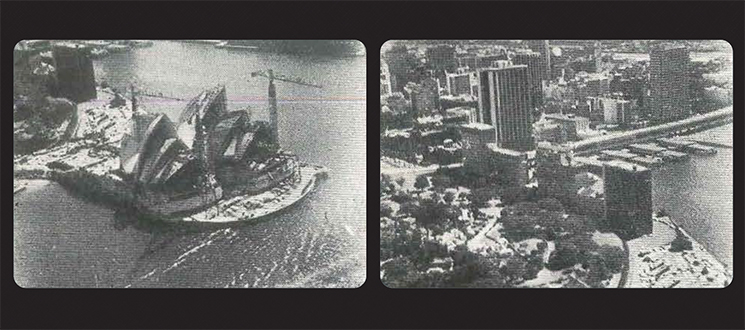
James William Reilly, the Scottish-born pilot, had shown coolness and professionalism under extreme circumstances several times before in his aviation career and, by all accounts, was not a man to panic easily. He had flown with the Royal Air Force during the height of the World War II bomber offensive against Germany.
He was known for his strict adherence to standard operating practices.
Reilly was also one of 4 survivors when the Lancaster he was flying was shot down in 1944, and became a prisoner of war.
He stayed in the RAF after the war and became a pilot in its first helicopter squadron, flying rescue flights in the UK, on operations for 3 years during the Malayan emergency of 1948–1960, piloting VIP transport flights and 101 casualty evacuations. He was awarded the Air Force Cross for actions during the Indonesian Konfrontasi with Malaysia.
He became experienced in successfully handling autorotations, including one that occurred under almost the worst possible conditions – at 150 feet when test-flying a tandem-rotor Bristol Belvedere with a heavy sling load. (A helicopter autorotation is an unpowered emergency landing after engine or transmission failure.)
Camera operator Frank Parnell had studied aeronautical engineering but found his true vocation behind the lens, where he was a founding member of the Australian Cinematographers Society. The small size of the Australian film industry in the 1960s was demonstrated by how British-born Patricia Ludford had worked with one of the men on the tug who filmed her death. She sat in the centre position of the Bell’s bench seat, with Parnell on the right and Reilly flying from the left side.
‘I often wonder what happened in those 45 seconds,’ Hobbins says. ‘There’s no evidence, no voice recording, but it’s reasonable to assume Jim had to deal with the human drama right beside him as well as work out what’s going on with the helicopter and what he can and can’t achieve, all while the helicopter is spinning once every 2 seconds, and fundamentally nose-heavy.’
The tail rotor gearbox detached from the helicopter and fell into the harbour.
The second impact
Bruce Reilly has a vivid memory as an eight-year-old of his mother taking a telephone call that Saturday. When asked in later years how she had retained a semblance of composure that terrible afternoon, she said years as a military pilot’s wife had prepared her well.
His elder brother had gone to Bankstown airport with their father and watched him fly a test flight to check the effect of the camera on the Bell’s weight and balance. Now he was waiting at the airport for a helicopter that would never return.
Today the Australian Transport Safety Bureau engages promptly with survivors and next of kin as part of its investigatory role. There was no such service offered in 1966 and the Reilly family had the ordeal of watching the external and onboard footage on television and overhearing acquaintances and strangers talking about it. Nearly 60 years later, this is the only aspect of the crash that Reilly finds hard to discuss dispassionately.
‘People really need to realise that there are family and friends associated with accidents and how damaging an off-the-cuff remark can be,’ he says. ‘It’s the same with the press. All those things have a flow-on effect that can make everything worse, deepen grief and extend it. For us as a family, it wasn’t particularly well managed. I remember looking at the crash on the news that night.’
A string of verdicts
The investigation team quickly focused on 2 contributory factors: the failed bolt and the helicopter not entering autorotation. Other possible factors such as the pre-Australian service history of the aircraft were not considered.
The Bell 47 had been flying slowly and climbing to 1,500 feet for a transit of the city. Apart from Parnell’s camera, it carried no recording devices but its height was estimated at about 1,000 feet, well within the safe area of the Bell 47’s benign height/velocity curves. However, this assumed height was at best a consensus – witness estimates varied wildly with some putting it as low as 400 feet. The DCA seized on the 1,000-feet figure in an investigation that reached a conclusion that seems shockingly superficial to modern investigative eyes.
‘Had the pilot immediately elected to initiate an autorotation landing, the catastrophic results which eventuated would have been largely mitigated, if not completely avoided,’ it said.
Macarthur Job, at that time editor of the department’s safety publication Aviation Safety Digest attempted, as was his pioneering practice, to produce a more nuanced multi-factorial report. In the November 1967 edition, he wrote, ‘By any standards, the situation which faced the pilot was a most unenviable one.
‘Overall, the evidence seems to point to a situation in which the pilot, while purposefully maintaining a power-on condition, despite the loss of directional control and the consequent fuselage rotation, was struggling to keep the aircraft airborne, and perhaps even endeavouring to gain height, until such time as the aircraft was in a better position from which to attempt an autorotational descent.’
Archival evidence has emerged of a draft of Job’s story, with another paragraph crossed out in pen. Hobbins suspects the department wanted to make a clear and unambiguous statement to Australia’s helicopter pilots that it expected higher standards from them and not have this contradicted by Job’s instinctive sense of fairness.’
The pilot may have decided against attempting to make an emergency landing because of the heavily populated area below him.
The crossed-out paragraph mentions the tailwind and the helicopter’s low airspeed which was ‘certainly well below that necessary to obtain stabilised autorotational flight … The pilot probably realised that any attempt to place the helicopter in autorotation would initially involve a sudden, substantial loss of height which could take the aircraft perilously close to the top of the buildings ahead, and to either side of his flight path. In addition to this, the pilot probably felt he would not be able to gain directional control until considerable height had been lost and sufficient forward speed had been gained for autorotational flight.’
The NSW Coroner’s finding of 1967 contrasted with the DCA position, determining that the pilot ‘may have decided against attempting to make an emergency landing because of the heavily populated area below him’.
Nine years of lawsuits followed the crash, to the anguish and frustration of all 3 families. The legal focus turned towards the tail rotor bolts, in a series of increasingly abstract court cases, culminating in an appeal to the High Court. The Bell company, found not to be at fault in a controversial High Court judgement in 1973, changed the design of the bolt in 1976.
As well, the department ruled that helicopters transiting Sydney must stay over water or open areas, a flightpath restriction that remains in force.
System and remembrance
Bruce Reilly says he would probably have followed his father into aviation, even if the crash had never happened. He became an engineer, specialising in helicopters and working on complex muti-engine types. The job gave him an appreciation of the importance of human factors in aviation safety and he became a safety systems inspector at CASA.
He is proud but unsentimental about his father. ‘Of course I’m biased, but I’ve spent a lot of time in archives and every report I read about him mentions how organised and disciplined he was,’ Reilly says. ‘And it’s not that the writers were trying to be nice to me because I’m his son.’
Among the sources he quotes is a 2003 UK Civil Aviation Authority review of tail rotor failures covering 40 models, which found the Bell 47 the worst for the quality and quantity of advice provided in its flight manual.
‘The philosophy back then was that if there was an accident, it was pilot error,’ Reilly says. ‘There was limited recognition of the multitude of other factors that we now know can lead to an accident. Only a systems safety approach, covering type certification, documentation, airspace, procedures and underlying culture, could have prevented it, but the helicopter industry had not reached that level of maturity in 1966.’
The Reilly family refused to be defined by tragedy. Jim and Elizabeth’s 4 children grew to be close, successful and mutually supportive. When a documentary producer approached them to tell their story, they declined. ‘We knew their angle would be “you poor kids” and that’s not how we felt,’ Reilly says.
‘Having him as father was something to celebrate. The time we had with him was amazing. Not just the travels, he was very much a family man. He had wanted to stop flying to be with us more, but we cherish the time we were given.

